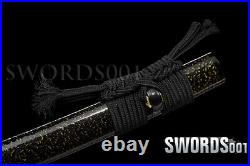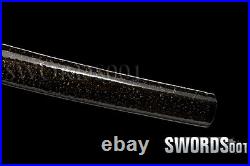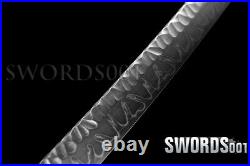Hand Forged Clay Tempered Japanese Sword Samurai Katana T10 Steel Iron Tsuba —



















Hand Forged Clay Tempered Japanese Sword Samurai Katana T10 Steel Iron Tsuba. Historically, katana (or) were one of the traditionally made Japanese swords (nihont) that were used by the samurai of ancient and feudal Japan. The katana is characterized by its distinctive appearance: a curved, single-edged blade with a circular or squared guard and long grip to accommodate two hands. Samurai katana as a weapon is famous for its beautiful shape. They are used as art collection and the symbol of samurai soul. Our sword allows you to make a collection or to send to friends as a present. The blade of this sword is made of. It is clay tempered. The high-performance blade has very good toughness and does not deform when bent at 90 degrees. The hardness is as high as 58. Cutting the wire does not hurt the blade. It can be used in battle or for display. We would highly recommend it as a gift. Anyone would be thrilled to receive a gorgeous sword as a gift! OVERALL LENGTH: 103 cm / 40.5 inch BLADE LENGTH: 70 cm / 27.6 inch TSUKA LENGTH: 26 cm / 10.24 inch BLADE WIDTH: 3.2 cm / 1.26 inch BLADE THICKNESS: 0.7 cm / 0.28 BLADE CRAFT: fully hand forged, water quenching BLADE MATERIAL: T10 steel. Clay tempered, real hamon. BLADE SHAPE: Shinogidukuri NAKAGO: full tang KISSAKI: medium (chkissaki). TSUKA(HANDLE): hard wood core, Hineri maki MEKUGI: 2 bamboo pegs TSUKA-ITO: black synthetic silk wrapping cord SAMEGAWA: white genuine rayskin FUCHI / KASHIRA / MENUKI: alloy TSUBA(HAND GUARD): iron HABAKi & SEPPA: brass SAYA: black lacquered wooden scabbard with black synthetic silk sageo. 1 sword with saya. (No display stand and other fittings along with). Before being quenched, a special clay mixture can be applied onto the blade to harden the edge and obtain different hardness on the blade. The clay mixture was a special recipe and considered a crucial trade secret, guarded protectively by sword making masters. It would contain such things as feathers, powdered bones, grass, etc. And would be applied to the edge of the blade before being quenched. During quenching, a chemical reaction between the clay mixture and the hot steel occurs during the sudden temperature drop and carbon is fed into the blade in high amounts, creating an extremely tough edge. A clay hardened blade can only be quenched in water, thus increasing the defect rate even more. Another way for clay tempering is to apply clay along the blade but let edge exposed. Thus, while quenching the blade into water, the uncovered edge will cool down suddenly, but the rest of blade will cool down slowly. Such differential temperature change results in the different hardness of the blade. So the edge is tough enough to cut, where the back of blade is soft /flexible enough to absorb the impact during cutting. Such quenching process usually will leave beautiful wavy tempered line on the blade, as known as “hamon” in Japanese swords term. If you don’t like the original mountings, you can choose the favorite ones from the options. Handle wrapping cord and saya cord should be the same color. If you only want to change one of them to another color, please inform of it specially. We can engrave English words, Chinese Characters on the blade for free. We can add or remove the machine-made wavy hamon for free. Usually thought be used for bloodletting only. It is also used to lighten the weight of the sword. We can add or remove Bo-hi for free. Most of our blades are sharp. We can also make the blade unsharpened for free if you require. The price varies from different swords. International Buyers – Please Note. Please contact with us before you leave feedback. We will try our best to solve the problem for you, thank you. Sometimes, you may not get our reply immediately due to the time difference among each country. However, please be assured that we’ll strive to reply you as soon as possible once we got your messages.

Categorised as: hand
Comments are disabled on this post